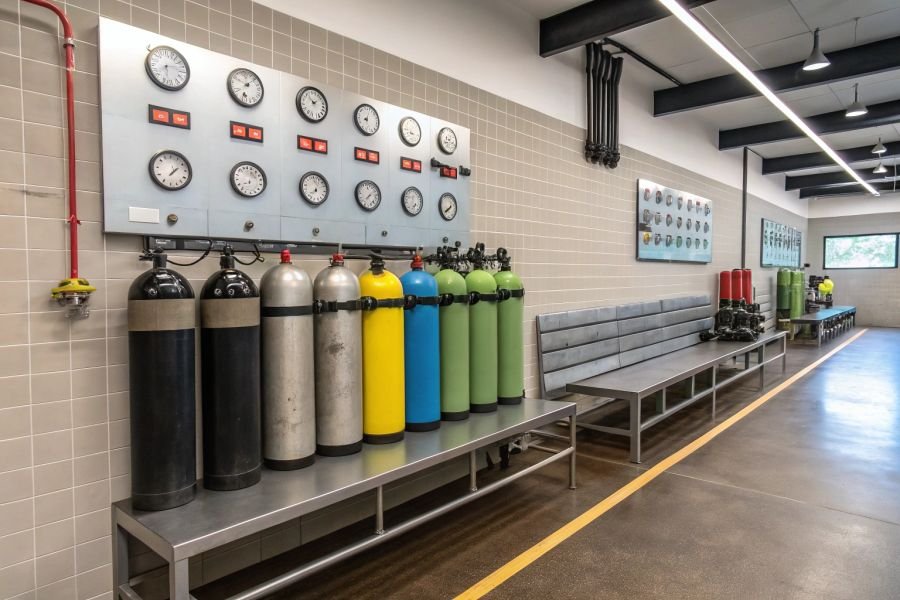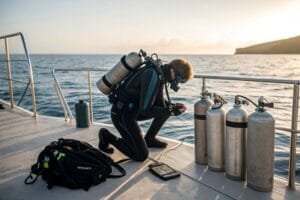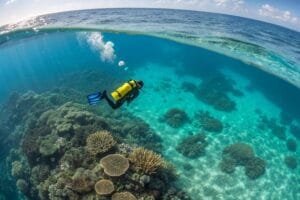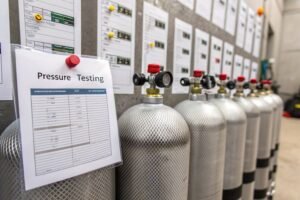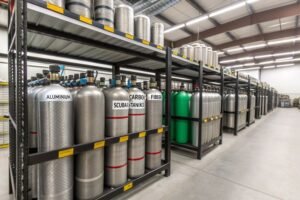Diving technology keeps changing, and many divers wonder if rebreathers will make traditional scuba tanks obsolete in the future.
Rebreathers offer longer dive times and better gas efficiency than traditional scuba tanks, but they won't completely replace open-circuit systems due to cost, complexity, and maintenance requirements that make scuba tanks essential for recreational diving.
As someone who has worked with diving equipment manufacturers for years, I've seen both technologies evolve. While rebreathers bring amazing benefits, scuba tanks remain the backbone of recreational diving. Let me share what I've learned about both systems and their future in the diving world.
What are the disadvantages of using a rebreather?
Rebreathers sound amazing on paper, but they come with serious challenges that keep many divers using traditional scuba tanks.
Rebreathers require extensive training, regular maintenance, expensive components, and constant monitoring of gas mixtures, making them less practical than scuba tanks for most recreational divers.
Cost and Complexity Issues
The biggest problem with rebreathers is cost. A decent rebreather system costs $5,000 to $15,000, while a quality aluminum scuba cylinder from our factory costs under $200. This huge price difference puts rebreathers out of reach for casual divers.
Maintenance is another major issue. Rebreathers need detailed pre-dive checks, component testing, and regular servicing. I remember talking to a diving shop owner in Australia who said his customers often skip proper maintenance because it takes too much time and money.
| Rebreather Disadvantages | Impact on Divers |
|---|---|
| High initial cost | Limits accessibility |
| Complex maintenance | Requires specialized training |
| Component failures | Can be life-threatening |
| Limited dive shop support | Repair challenges |
| Training requirements | Time and cost intensive |
Safety Concerns
Rebreathers can fail in dangerous ways. CO2 scrubber problems can cause unconsciousness underwater. Gas mixture errors can lead to oxygen toxicity or hypoxia. These risks require constant attention and monitoring that many recreational divers find stressful.
Traditional scuba tanks are simple. If something goes wrong, you can usually tell right away. With rebreathers, problems can develop slowly without obvious warning signs.
How long can rebreathers last?
The lifespan of rebreathers depends on several factors, but they generally provide much longer underwater time than traditional scuba systems.
Most recreational rebreathers provide 2-6 hours of dive time, while technical rebreathers can support dives lasting 8-12 hours or more, depending on depth, activity level, and scrubber capacity.
Dive Duration Factors
Water depth affects rebreather duration significantly. At shallow depths, the CO2 scrubber lasts longer because you produce less CO2. Deeper dives mean harder work and faster scrubber consumption.
Physical activity matters too. Swimming hard or working underwater increases CO2 production, which shortens scrubber life. Relaxed diving extends the system's duration.
From my experience working with technical diving customers, rebreather duration varies widely:
| Dive Type | Typical Duration | Limiting Factors |
|---|---|---|
| Recreational (30-60 feet) | 3-5 hours | CO2 scrubber capacity |
| Technical (100-200 feet) | 2-4 hours | Gas consumption, scrubber |
| Cave diving | 4-8 hours | Mission requirements |
| Military operations | 6+ hours | Stealth requirements |
System Limitations
The CO2 scrubber is usually the limiting factor. Once it's exhausted, the dive must end. Some rebreathers have scrubber duration indicators, but many rely on dive time calculations.
Battery life also limits rebreather use. Electronic systems need power for monitoring and control. Most units provide 10-20 hours of battery life, but cold water reduces this significantly.
Do Navy SEALs use rebreathers?
Military diving units, including Navy SEALs, do use rebreathers for specific missions where stealth and extended bottom time are critical.
Navy SEALs and other military divers use closed-circuit rebreathers for covert operations because they produce no bubbles, allow longer underwater missions, and reduce logistical support requirements compared to open-circuit scuba systems.
Military Rebreather Applications
Military units choose rebreathers for stealth operations. Traditional scuba tanks create bubble streams that reveal diver locations. Rebreathers produce no bubbles, making detection much harder.
Extended mission time is another advantage. A SEAL team can stay underwater for hours without surfacing, which is impossible with standard scuba tanks. This capability is essential for harbor infiltration, ship inspection, and underwater demolition work.
I've worked with military equipment suppliers who explained that special forces units train extensively on rebreather systems. The training takes months and includes emergency procedures, maintenance, and gas mixture management.
Operational Advantages
Military rebreathers offer several benefits over civilian models:
| Military Feature | Operational Benefit |
|---|---|
| No bubble signature | Covert operations |
| Extended duration | Long missions |
| Mixed gas capability | Variable depth operations |
| Ruggedized construction | Harsh environment use |
| Redundant systems | Mission critical reliability |
However, military units still use open-circuit scuba for training, shallow operations, and situations where simplicity matters more than stealth.
What is the 120 rule in scuba diving?
The 120 rule is a simplified method for calculating no-decompression limits, though it's not widely accepted by modern diving organizations.
The 120 rule suggests that depth in feet plus bottom time in minutes should not exceed 120 to avoid decompression stops, but this rule is considered outdated and potentially dangerous by current diving standards.
Understanding the 120 Rule
This rule attempts to simplify dive planning. For example, at 60 feet depth, you could stay 60 minutes (60 + 60 = 120). At 80 feet, you'd have 40 minutes (80 + 40 = 120).
The problem is that this rule doesn't match modern decompression science. Current dive computers and tables use more complex algorithms based on nitrogen absorption rates, tissue compartments, and safety factors.
Professional diving instructors I know in Southeast Asia stopped teaching this rule years ago because it can put divers in dangerous situations.
Modern Dive Planning
Today's divers use dive computers or official decompression tables. These tools consider multiple factors:
| Modern Considerations | Why Important |
|---|---|
| Tissue compartments | Different tissues absorb nitrogen at different rates |
| Repetitive dive factors | Previous dives affect current dive limits |
| Safety margins | Account for individual variation |
| Altitude adjustments | Higher elevations require modified limits |
| Gas mixture effects | Nitrox and other gases change calculations |
Safety Recommendations
Instead of the 120 rule, divers should use certified dive tables or computers. These provide accurate no-decompression limits based on current scientific understanding.
Conservative diving practices are always better. Stay well within computer limits, make safety stops, and plan dives within your training and experience level.
Conclusion
Rebreathers won't replace scuba tanks completely because of cost, complexity, and maintenance requirements that make traditional systems more practical for most divers.

